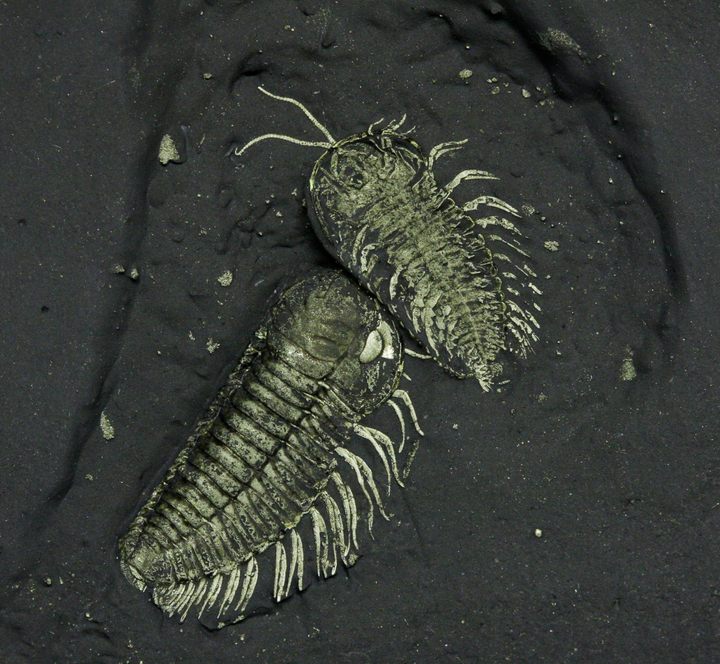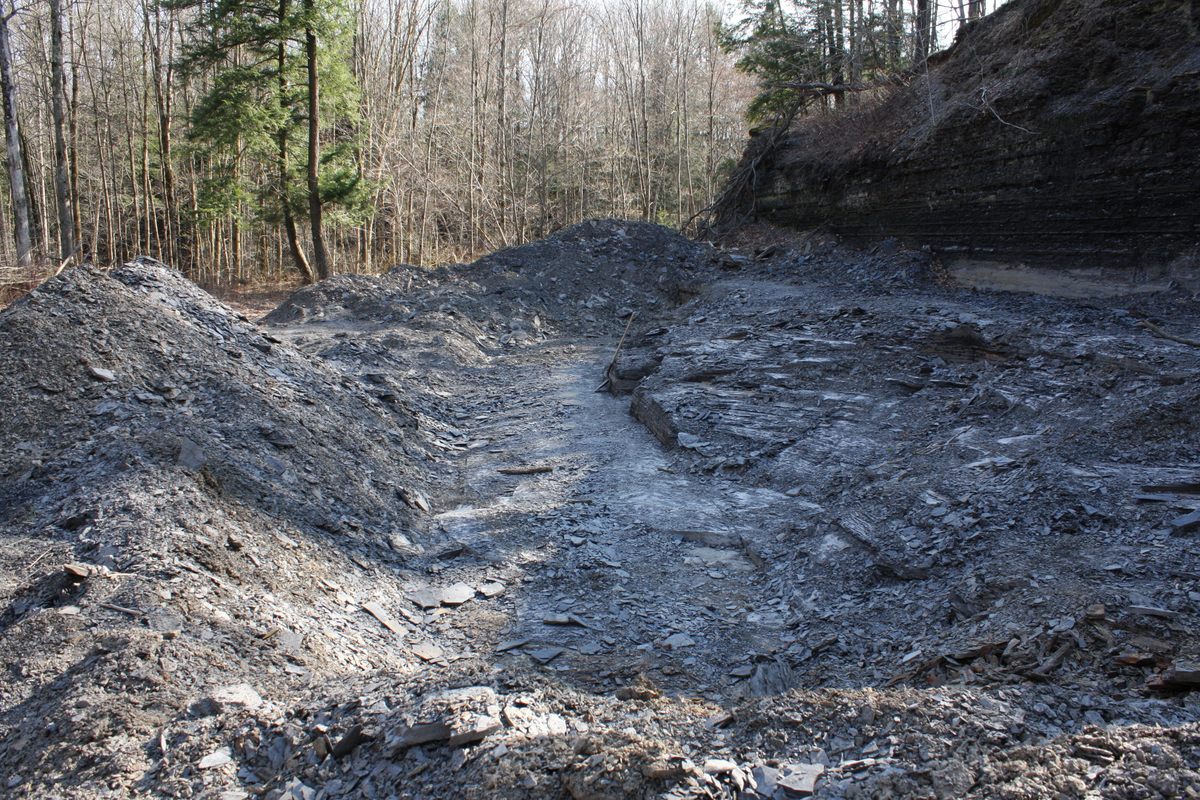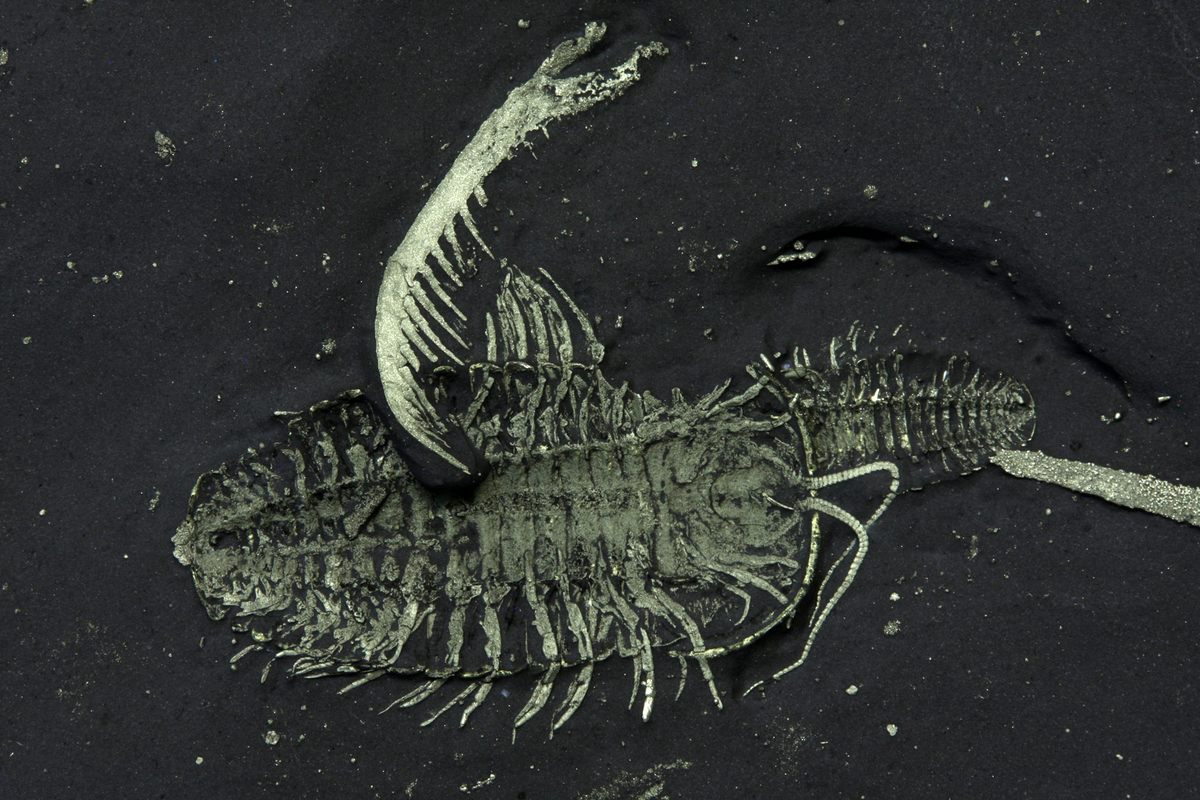
In Upstate New York, Ancient Arthropods Can Get Turned Into (Fool’s) Gold
Pyritized trilobites aren’t just flashy—they preserve incredible detail.
Unlike most prospectors who seek their fortune in gold, Markus Martin got lucky on his very first try. He’d come to a desolate patch of forest in upstate New York in hot pursuit of trilobites. It was the early 2000s and Martin’s day job was in finance, but he was far more interested in the treasures of another era: the Ordovician, from 485 to 444 million years ago, when trilobites roamed the sea that covered most of what is now North America. But Martin wasn’t looking for more ordinary trilobite fossils in muddy brown and dull black rocks. He was looking for glittering ones, whose soft tissues had been filled in perfectly with pyrite, the mineral commonly known as fool’s gold.
Martin was no fool. He knew the fossil beds in the area had a reputation for holding these brilliantly preserved arthropods, and he’d spent the hostile New York winter reading up to ascertain the best place to start looking. Martin scoured Microsoft’s TerraServer (this was a world before Google Maps) and picked a hill in an area riddled with slivers of canyons running 200 feet down into the shale, just three miles off a road and close to where he lived in Oneida County. Martin got permission from the landowner to search the area, and as soon as it was warm enough, he drove up with a backpack and a hammer. “I expected this was going nowhere, and that on Monday I’d go back to work with not much to say,” he says. But when he reached the base of the hill, he saw tiny, glittering trilobites sprinkling the forest floor, like flecks of gold in a river. “To say I was surprised is an understatement,” he says. Martin picked up as many as he could carry, around 30 specimens, piled them into his backpack, and lugged it all home.
Now Martin is perhaps the leading expert on New York’s gaudiest fossils. He left the finance world a few years ago—“It was a career field that I hated,” he says—and is now full-time in the trilobite world. He’s begun hunting for the fossilized critters across the world, though nowhere boasts specimens quite like the ones close to home.

For Martin, trilobite-hunting runs in the family. In the early 1900s, Martin’s great-grandmother, Catherine Valin, went on high school field trips to collect fossils by Whetstone Gulf, a state park in Lewis County. The trips were organized by Rudolf Ruedemann, a teacher at her school who later became the state paleontologist of New York, and Whetstone Gulf teemed with the tiny fossilized arthropods. Valin passed her passion down to her family, and Martin remembers family trips to the park—back when it was legal to collect fossils in state parks. Now, Martin only excavates where he has a permit or a lease for the site.
Martin first found pyritized trilobites in an area now called Martin Quarry (yes, it was named after him), the majority of them come from a deposit called Beecher’s Trilobite Bed. Like Martin Quarry, it was named for the man who discovered its ancient treasures. Charles Emerson Beecher, a paleontologist at the Peabody Museum of Natural History at Yale University, first excavated the site in 1893. Though Beecher never thought to record the site’s location, he did find and prepare more than 500 specimens of the trilobites Trinucleus and Triarthus, each exquisitely preserved in pyrite, until his sudden death in 1904, according to an obituary written by William Healey Dall and read before the National Academy of Sciences. Beecher’s Bed was lost until 1982, when Yale paleontologists found it and set to work on it again. Martin took over the site in 2009, after Yale chose not to renew its lease on the property.

After collecting that first bag of specimens, Martin reached out to some paleontologists and museums to see if there was any interest in what he found. He got a few bites. One came from James Hagadorn, a paleontologist at Amherst College who drove out two days later to see the site. Another was Thomas Whiteley, a retired Kodak executive who had written “the definitive book on the trilobites of New York,” Martin says. For the next five years, Whiteley mentored Martin on all things paleontology: how to find fossils, how to excavate them properly, and, most painstakingly, how to prepare them.
“Being in my late 20s was good,” Martin says. “At that age, when you’re passionate about anything you’ll find the time. You’ll sacrifice the sleep.” After finishing his finance job in Watertown at 5 pm, Martin would drive an hour out to the quarry to collect fossils until the sun went down. In the winter, Martin prepared the fossils by carefully removing the surrounding rock with a micro-sandblaster, which blows a stream of tiny particles to wear away rock. “You’ll burn the details off them if you’re too rough,” he says. “But at least in the winter, there’s nothing else to do.”
As Martin studied his prize finds, he realized that New York’s golden trilobites were special for more than their appearance—though that did make them stand out, like Eric the opalized pliosaur. The fossils are what’s known as pseudomorphs, minerals that form in the place of another mineral, writes paleontologist Steven Schimmrich at the State University of New York Ulster, in his blog. In the case of the Beecher trilobites, the animals must have been buried in an underwater landslide. As the trilobites decayed, sealed off from oxygen, they released sulfides that reacted with dissolved iron in the surrounding water to form pyrite. It is an exceptionally rare process that can only occur in certain circumstances, Schimmrich writes. But when it does happen, it offers remarkable preservation of detail.

In general, trilobite fossils are so common that you can buy a 10-pack on Etsy for $20. But the pyritization process allows for the preservation of the minute details, such as thread-like legs and microscopic eggs, that disappear in many other examples. Martin uncovered one 450-million-year-old ostracod crustacean, also called a seed shrimp, that was immortalized in pyrite alongside her eggs and hatched embryos, as well as some neighboring Triarthus trilobites, according to a study published in Current Biology in 2014. In 2017, Martin coauthored a paper documenting the first observed trilobite with preserved eggs. Each tiny oval was around 200 micrometers in size, smaller than a grain of table salt. The eggs were found inside the trilobite’s head. Modern horseshoe crabs release their eggs from around the same area, perhaps hinting at where the first arthropods stored their eggs, according to Scientific American.
Martin documents the best of his finds on his instagram, @goldbugsofficial. Trilobites aren’t technically bugs, but the arthropods earned the nickname due to their uncanny resemblance to rolly pollies (also known as pill bugs). He’s amassed a considerable following, but being a fossil influencer still has drawbacks. Martin says his account is flagged as inappropriate approximately 10 times a day, though not for the reasons you might think. “A lot of it is creationists,” he says, many of whom believe that trilobites went extinct after the Great Flood. (It was more like 250 million years ago.) He also receives the occasional complaint from “purist academics” who believe fossils should only be handled by people with PhDs. But the latter complaint has not affected Martin’s scientific publishing schedule, as he’s contributed to seven papers and is working on several more. “Markus’ discoveries are nothing less than phenomenal,” Hagadorn writes in an email. “The trilobites preserved at his new sites have already changed our understanding of this group, who were the ‘cockroaches of the sea’ for 200 million years.”
According to Martin, the most wondrous thing about the pyritized trilobites is their vast variety—not in size (almost all are less than an inch long) or species (almost all are Triarthus), but in the many ways they died. “The variety of states of rigor mortis is pretty incredible,” he says. “Because Beecher’s has this unique preservational setting, it’s a true snapshot of everything going on with these trilobites.”

One of his recent favorites is a trilobite preserved alongside a raptorial arm from Anomalocaris, a three-foot-long, shrimp-like superpredator that sat at the top of the food chain in the Cambrian Era, when trilobites first evolved. The trilobite did not appear to have been killed by the arm, and the arm itself had clearly been detached from the predator, evidenced by some ragged flesh fossilized at the end of it. “I think Anomalocaris picked too big a trilobite to eat,” Martin says, though he admits it’s impossible to really know what happened. “You see trilobites squished and squeezed and twisted all across North America, so it’s hard to know if that stuff happened before or after they died.”
Today, Martin’s lovingly excavated and prepared trilobites are scattered in museums or private collections. An impressive 178 of his fossils are now housed in the collection of Yale’s Peabody Museum, including specimens of algae and seed shrimp, and—you guessed it—buckets of trilobites. One Martin Quarry fossil preserving the bodies of two trilobites, one large and one small, even wound up in the collection of the National Museum Wales.
Over the years, Martin has tried to teach his two grown sons how to sandblast golden trilobites in a prep lab in his basement, to varied success. “One now has no interest, and the other kind of comes and goes, which is too bad because he was the best of all of us,” he says. “But it’s okay if he’s not interested.” If history is any indication, trilobite fanaticism in the Martin family might skip a generation or two.























Follow us on Twitter to get the latest on the world's hidden wonders.
Like us on Facebook to get the latest on the world's hidden wonders.
Follow us on Twitter Like us on Facebook